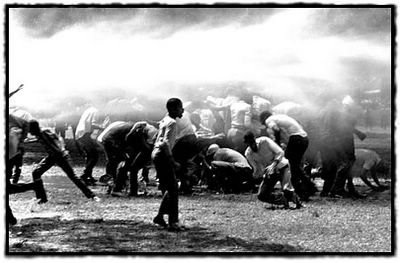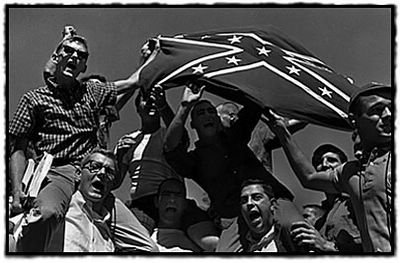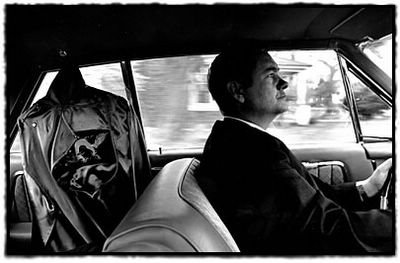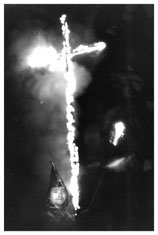
1963 BIRMINGHAM ALABAMA PROTESTERS KNEEL IN PRAYER BEFORE THEY ARE ATTACKED BY POLICE & FIREFIGHTERS
Posted by Picasa

"BULL" CONNOR OF BIRMINGHAM ALABAMA 1963
Posted by Picasa

1963 BIRMINGHAM SEGREGATIONISTS TURN HOSES ON CIVIL RIGHT DEMONSTRATORS
Posted by Picasa

1963 BIRMINGHAM ALABAMA CIVIL RIGHTS DEMONSTRATORS ATTACKED WITH FIREHOSES
Posted by Picasa

Mississippi, 1962.
1962 Local LAWMEN show what they plan to do to U.S. Marshals, sent to assure the admission of James Meredith as the first black student at the University of Mississippi ("Ole Miss").
Posted by Picasa

1962 WHITE SUPREMACIST HOLD UP CONFEDERATE FLAG TO PROTEST AGAINST INTEGREGATION AT "OLE MISS"
Posted by Picasa

1965 KU KLUX KLAN GRAND DRAGON JAMES JONES & THE BANALITY OF EVIL
Posted by Picasa

1965 NORTH CAROLINA KU KLUX KLAN GRAND DRAGON JAMES R.(BOB) JONES POSES AFTER LIGHTING A CROSS BEFORE A MIDNIGHT GATHERING
Posted by Picasa
The photos above are by the American photographer Charles Moore who helped to publicize the Civil Rights Movement ‘s struggles.
“Charles Moore didn't plan to photograph the civil rights movement. In September, 1958, he was a 27-year-old photographer for the Montgomery (Alabama) Advertiser. When an argument broke out between the Reverend Martin Luther King, Jr. and two policemen, Moore was the only photographer on the scene. His striking pictures of Dr. King's arrest were distributed nationwide by the Associated Press, and one was published in Life magazine. A new career had begun.
Over the next seven years, Moore made some of the most significant pictures of the civil rights movement. As a contract photographer for Life magazine, Moore traveled the South to cover the evolving struggle. His photographs helped bring the reality of the situation to the magazine's huge audience, which at the time comprised over half the adults in the United States. According to former U.S. Senator Jacob Javits, Moore's pictures "helped to spur passage of the Civil Rights Act of 1964." “
see website: KODAK: “POWERFUL DAYS IN BLACK & WHITE” of the Civil Rights Movement
&_ ABOUT CHARLES MOORE
Above are a few more images of the struggle of " THE CIVIL RIGHTS MOVEMENT" in the United States. One of the reasons I want to share these images with you dear reader is that many Americans like to pretend or propagandize the view that the United States has had a long history of being a democratic & just society which is not in fact the case. Black Americans were treated like second class citizens in their own country til just a couple of decades ago. That is if we accept the belief that African-Americans & other visible minorities are now treated better in America today than they were. Unfortunately racism is still alive & doing well in America. Unemployment & poverty are still disproportionately higher within the Black population than in the white population. Every week we see on TV images of another Black/ African- American man being beaten viciously by police officers. Or another African-American young boy shot to death by police because he was riding his bike or running down a sidewalk.
Anyway here’s some bits about Bull Connor & the Civil Rights Movement gleaned from the net:
.
One of the most enduring images of the Civil Rights Movement is that of Birmingham firemen and policemen using water hoses and police dogs against African-American demonstrators in 1963 Birmingham. The episode came during the first week of May, following a month of peaceful demonstrations by Birmingham's African-American community against their city's segregation ordinances. Civil rights leader Martin Luther King, Jr., who described Birmingham as "the most segregated city in America," organized the demonstrations with the help of local civil rights leader Fred L. Shuttlesworth and others. "Bull" Connor tried to stop the growing demonstrations, and gained lasting infamy when he resorted to using the water hoses and dogs. Televised reports of police dogs lunging at African-American citizens and people being washed down the streets by water from powerful fire hoses dramatized the plight of African-Americans in segregated areas. The events in Birmingham helped mobilize the administration of President John Kennedy to begin efforts leading to the most far-reaching civil rights legislation in history, the Civil Rights Act of 1964. The name "Bull" Connor thus came to symbolize hard-line Southern racism. Ironically, Connor's heavy-handed defense of segregation in 1963 Birmingham actually hastened the passage of America's Civil Rights Act.
ADAH: Alabama Moments (Bull Connor)
www.alabamamoments.state.al.us
Powerful Days: Civil Rights/Birmingham Police Commissioner Bull Connor
Cocky as ever and unaware of how much his actions have aided the civil rights
cause, police commissioner Bull Connor struts through Kelly Ingram Park, ...
www.viscom.ohiou.edu/moore.site/Pages/birmingham
Segregation was still the law of the land as far as the citizens of Birmingham, Alabama, were concerned despite Supreme Court decisions to the contrary. In his inaugural remarks in 1957, upon winning the post of Commissioner of Public Safety after a four-year hiatus from politics, Connor said: "These laws [segregation] are still constitutional and I promise you that until they are removed from the ordinance books of Birmingham and the statute books of Alabama, they will be enforced in Birmingham to the utmost of my ability and by all lawful means." (p. 61)
Connor's popularity, as demonstrated by his six victories in city commission races, came from white voters -- workers and corporate leaders alike. His reputation among the rank-and-file was that of an honest, albeit colorful man who maintained "his willingness to keep blacks `in their place'" (p. 181)
Connor had the backing of the local corporate elite in spite of his declarations of being free of outside influence. Connor helped the industrial elite by "controlling strikes...silencing radicals.... Connor was exactly what companies that controlled Birmingham were looking for...." He was counted on to keep the status quo. Connor "stayed on the good side of the business leaders... [and was] always receptive to corporate suggestions." His preaching about economy in government and no new taxes reflected the influence of Birmingham's industrial and financial interests, who "always insisted in cheap government with only bare essential services." (p. 182)
BULL CONNOR
www.unt.edu/lpbr/subpages/reviews/nunnell
the Law & Politics Book Review
BULL CONNOR by William A. Nunnelly. Tuscaloosa: The University of Alabama Press, 1991. 225pp.
Reviewed by Jolanta Juszkiewicz, Pretrial Services Resource Center, Washington, D.C.
see: Website WE SHALL OVERCOME
Historic Places of the Civil Rights Movement
http://www.cr.nps.gov/nr/travel/civilrights/index.htm
Anyway that’s all for now,
GORD.
2 comments:
Very nice. I lived through that period -- and took part in some of the struggles. We have come such a long way. I think we're going rapidly downhill now, though, which will be a pity.
Question of the century though. Was it oppressive for people to have separate spaces with the independence to change their own spaces? Native Americans don't seem to think so. It's pretty clear that very few black people felt oppressed as they were fighting for more access to the spaces and money of their "horrible oppressors." I would think as a Christian you would respect the Bible and be pro-ethnonantionalism as per the instructions throughout Genesis, the Old Testament being entirely ethnonationalist, Acts instruction to separate people, and Revelations also. The Biblical instruction to separate people of different lineages are certainly much stronger than MLK's lack and manipulation of Biblical teaching, which you would expect as his writings deny all miracles of Jesus, including his birth and resurrection https://kinginstitute.stanford.edu/king-papers/documents/what-experiences-christians-living-early-christian-century-led-christian I feel like you're being led down a particularly dangerous route. King, Malcolm X, JFK, all recognized that the black community was filled with militants and was committing tons of violence during this period. The "peaceful protest" myth is really selective and doesn't look at how most of the riots actually started.
Post a Comment